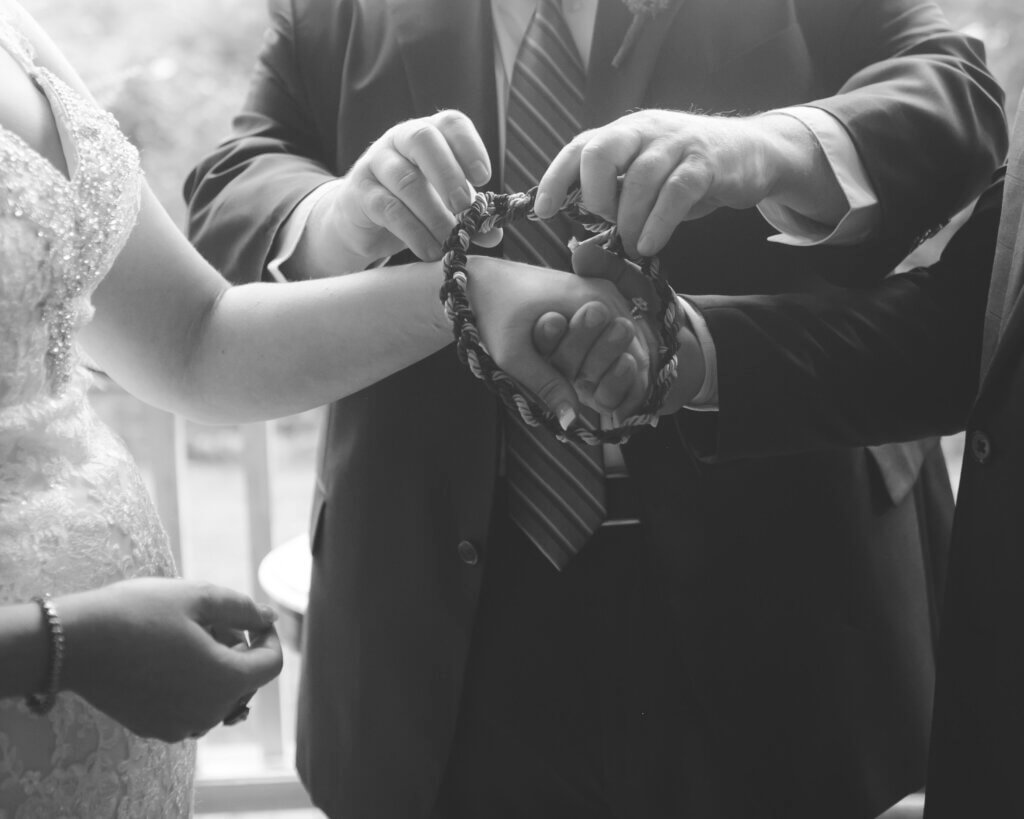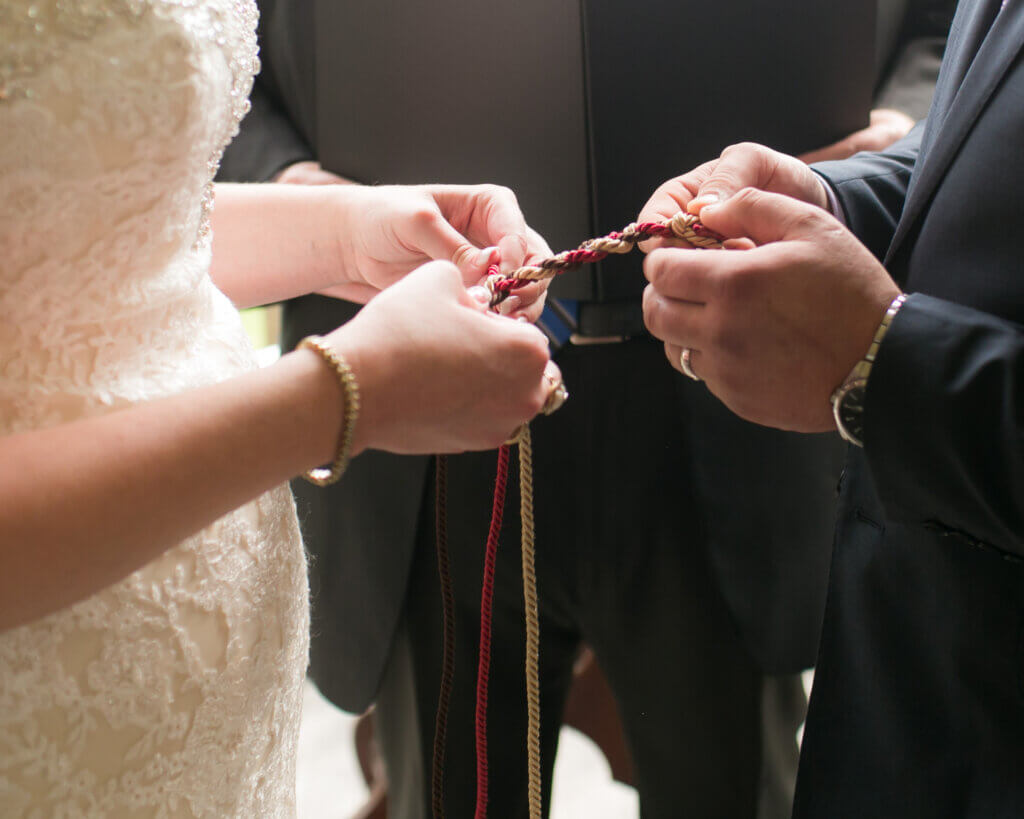This unique handfasting ceremony gives an old ritual a new take.

Written by Meggan Hoyman
IMAGES COURTESY OF MEGGAN HOYMAN. PHOTOGRAPHED BY AMANDA KISAMORE.
When I was planning my wedding, I really wanted everything we incorporated to have meaning. I spent a lot of time researching and customizing our nuptials. One of my favorite parts was our Christian Handfasting Ceremony. We got so many compliments on this portion, and it left us with a keepsake that we like better than a half-burned candle or a bottle of sand.
I wanted to do a handfasting ceremony because I was enamored with the symbolism of being bound together forever. It is a tradition that dates back to the Middle Ages in Great Britain and Ireland, and it’s where we get the phrase “tying the knot.” Historically related to betrothal, handfasting was legally binding and signified that the couple accepted each other as man and wife. It was typically followed soon after by a church wedding.
In the modern era, handfasting is often associated with pagan or non-religious ceremonies but is also still sometimes used in the church. The priest will typically wrap his stole around the couple’s hands and quote Mark 10:9 , “Those whom God has joined together, let not man put asunder.” This was done in both the British Prince William’s and Prince Harry’s weddings.
I did a lot of research and never found quite what I wanted, so I created my own version for our wedding ceremony. We did this right after we exchanged rings and just before the final blessing and kiss. Not only did it beautifully reflect the symbolism of being bound together in marriage forever; it also reflected our Christian beliefs of being joined as man and wife in union with God. We also took this time to have our families say prayers of blessing over our union. It was a beautiful and moving moment, and probably my favorite part of the ceremony—aside from being announced as husband and wife for the first time!
The pastor introduced this portion of the ceremony by reading the following:
Ecclesiastes 4:9–12 reads, “Two are better than one, because they have a good return for their work: If one falls down, his friend can help him up. But pity the man who falls and has no one to help him up! Also, if two lie down together, they will keep warm. But how can one keep warm alone? Though one may be overpowered, two can defend themselves. A cord of three strands is not quickly broken.”
Today, the bride and groom have chosen to braid three strands together into a single cord. Each strand has a significant meaning. One strand represents God and His majesty. One strand represents the groom and his life. And one strand represents the bride and her life. In braiding these three strands together, they have demonstrated that their marriage is more than a joining of two lives together. It is a unity with God as well. They have chosen to allow God to be at the center of their marriage, woven into every aspect of it. It was God who taught us to love. By keeping Him at the center of your marriage, His love will continue to bind you together as one throughout your marriage.
After introducing the ceremony to the congregation, we invited our parents to join us at the altar and encircle us with prayer to bless our union while my sister sang “When I Say I Do” by Matthew West.
As my sister continued to sing following the prayers, we braided the cord. I thought about trying to braid it together, passing cords to each other, but, considering how sweetly nervous my husband was and the fact that we didn’t do a wedding rehearsal, we went a different direction. My husband held the braid at the top, and I braided all three strands myself to the bottom. This ended up working out perfectly, as I finished the braid just as the song came to an end.

We then transitioned to the actual handfasting. The Pastor began by saying this as he bound our hands with the cord:
As this knot is tied, physically binding your hands together, it symbolizes the binding of your lives one to another. With the entwining of this knot, I tie all the desires, dreams, love, and happiness wished and prayed over you here in this place today. This cord also represents the binding of your vows to each other and before Christ. May this cord draw your hands together in love, never to be used in anger. May the vows that you have spoken never grow bitter in your mouths. Two entwined in love, bound by commitment and fear, sadness and joy, by hardship and victory, anger and reconciliation. Bound in faith, hope, and love. Hold tight to one another and to God through both good times and bad, and watch as your strength and love grow through the years to come.
After our hands were bound, my best friend, Ashley, read this poem:
“Blessing of the Hands”
These are the hands of your best friend, young and strong and full of love, that hold yours on your wedding day.
These are the hands that will work alongside yours as you build your future together.
These are the hands that will passionately love you and care for you throughout the years.
These are the hands that will hold you when fear or grief torments your mind and, with the slightest touch, will comfort you like no other.
These are the hands that will give you strength when you struggle and support and encourage you to chase down your dreams.
These are the hands that will tenderly hold your children and help keep your family together as one.
These are the hands that will, countless times, wipe the tears from your eyes, tears of sorrow and tears of joy.
And lastly, these are the hands that, even wrinkled with age, will still be reaching for yours, still giving you the same unspoken tenderness with just a touch—a touch from these hands.
“Blessing of the Hands” is sometimes attributed to the early 20th century works of the Irish poet Francis Reilly, but most often it is cited as Author Unknown.
After the reading, the pastor said his final blessing and announced us as man and wife. We left our hands bound as we shared our first kiss and through the recessional. It was deliberately tied loosely enough that we could slip our hands out without undoing the knot, and we now have the tied knot preserved as a reminder of being bound together as man and wife. How great is that?

